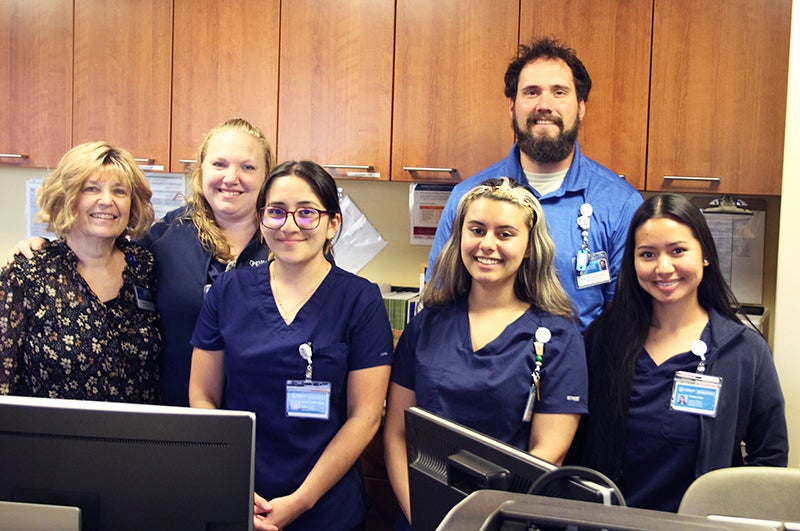Riverland, Mayo partner for practical training experience
Published 5:38 pm Friday, June 2, 2023

- Lesa Anderson works as a registered nurse and nurse administrator for Mayo Clinic in southeast Minnesota, while Brian Doering works within the medical assistant program for Riverland Community College students in Albert Lea. From left, Lesa Anderson, Michele Fogelquist, Jocelyn Cortez, Brianna Winter, Brian Doering and Victoria Htoo. Provided
|
Getting your Trinity Audio player ready...
|
Across the country, there’s a shortage of registered nurses. In 2021, the American Association of Colleges of Nursing turned away more than 90,000 applicants from nursing programs at colleges and universities, according to the Mayo Clinic.
In 2022 Chris Wolf, dean of Riverland’s School of Nursing and a former Mayo Clinic Health System employee, notified Cheristi Cognetta-Rieke, chief nursing officer of Mayo Clinic Health System in Southeast Minnesota, and told her the school was considering limiting enrollment because of a faculty shortage in the nursing program.
That was a problem, considering Mayo worked with Riverland’s school of nursing to encourage students to pursue a career locally upon graduation.
So Cognetta-Rieke committed to teaching Friday evening clinical courses until Riverland could find more staff.
Her commitment inspired five more nurses and leaders to volunteer to teach, and now six Mayo Clinic Health System staff work as adjunct faculty members for the ADN-RN program at Riverland, providing connections from the classroom directly to the nursing field.
Cognetta-Rieki and Lesa Anderson, a registered nurse and nurse administrator for Mayo Clinic in southeast Minnesota, recently served as adjunct instructors for the nursing program at Mayo Clinic Health System in Austin.
“We have such a vested interest, there’s such a nursing shortage,” Anderson said. “We have a vested interest in working with Riverland from a collaborative standpoint to make sure that those students would have robust clinicals. We just came off COVID where some of their clinicals were virtual clinicals, and we really wanted them to have a good experience, hands-on, face-to-face with patients.”
And because Anderson had always wanted to teach as part of her professional development, she saw this as an opportunity. Prior to January, she had never taught or overseen before, though she said that serving as a manager at a different organization she was always informally teaching.
During their first meeting with students, they asked them what students wanted to gain from the program to build their confidence. A common refrain: virtual didn’t provide the same experience as meeting patients and their families on a regular basis.
During their rotations, students worked within the Emergency Department, the Intensive Care Unit, the Medical Search Department, the Obstetrics Department and the Psychiatric Department, the last of which was based at the Albert Lea clinic.
Within the Psychiatric Department, students did more observations where they would go into group therapy.
“When you’re in school you get the theory behind what you need to do, and when you come into the clinicals you take that theory and put it into practice,” she said.
The experience has provided her a sense of enjoyment in teaching, especially in-patient work, something she enjoyed as a former ER nurse.
“It was just nice getting back into the hospital, helping students understand the ‘Whys’ behind everything that they’re asked to do,” she said.
That said, she admitted teaching students now was a different experience than learning when she was a student 20 years ago, noting that environmentally it was a different place.
“I don’t remember the violence that, as nurses, we were exposed to back when I started in my nursing career,” she said. “It seems that the anxiety level of our patients is higher in patients, and their patience is lower.”
It was her job to oversee student practical experience, so when they were in Austin she would match students nurses on the floor, where they would help take care of a patient during a shift. John Roshein oversaw the floor when students would do their psychiatric work.
Her particular cohort was on Fridays and ran from 3 to 11 p.m., and while she wasn’t physically present at the Albert Lea campus, a nurse manager in Albert Lea was there when a student rotation was in Albert Lea.
This was her first teaching experience with nursing students, and Anderson admitted it was nice to be connected to students, especially as it pertained to real-world experience.
She would also like to teach again, should an opportunity arise that fits with her schedule. Anderson would also consider transitioning to teaching during retirement.
Out of the differing cohorts from the past semester (which ran from January to May), 12 students were hired, seven from Cognetta-Rieke and Anderson’s Friday cohort.
Riverland also provides medical assistant training through Mayo Clinic Health System, something John Doering, the nurse manager for family medicine, oversees for Riverland students in Albert Lea.
“A medical assistant is a form of licensure, it’s not quite a [licensed practical nurse],” he said. “Medical assistants can do almost the same exact type of work barring a few certain procedures or giving certain vaccinations.”
Students also get access to a medical charting program, patient charts, patient care plans and experience working with recording patient information to share with physicians, as well as follow-up work if needed.
Last year, the two student MAs at Mayo Clinic Health Systems Albert Lea were hired following completion of the program.
“They saw the unit, they liked the environment, the culture that was here and they applied for what we had posted,” he said.
According to Doering, Riverland has partnered with Mayo Clinic Health System to provide practical medical assistant experience for four years.



